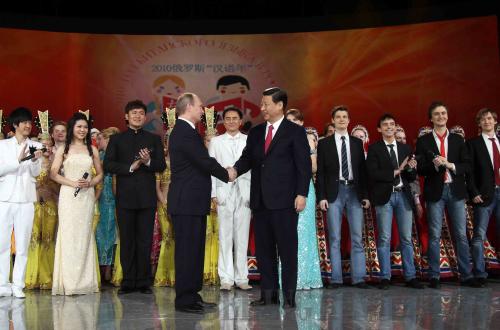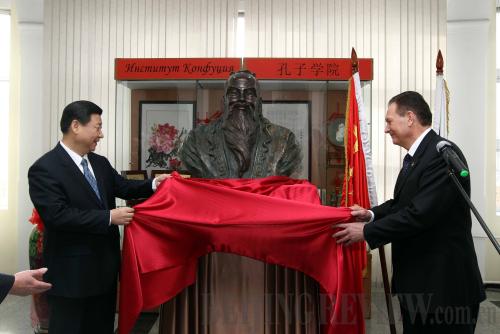|
 |
|
CULTURAL BONDS: Chinese Vice President Xi Jinping (right) and Russian Prime Minister Vladimir Putin attend the opening of the Year of the Chinese Language in Russia, in Moscow on March 23 (LAN HONGGUANG) |
Despite the chill that often characterizes weather in Russia's biggest Pacific port city, Chinese Vice President Xi Jinping received a warm welcome in Vladivostok on the first leg of his most recent trip on the way to Moscow.
Vladivostok, the administrative center of the Russian Far East region of Primorsky bordering northeast China, is also Russia's principal sea hub on the Pacific Ocean.
The intent of the visit was to "broaden and deepen China-Russia interregional cooperation," Xi said while meeting with Primorsky's Governor Sergey Mikhaylovich Darkin.
The trip helped solidify this move based on a September 2009 plan approved by Chinese President Hu Jintao and Russian President Dmitry Medvedev to specifically invigorate areas between northeast China and Russia's Far East region.
Xi's visit to Russia, from March 20 to 24, represented a major step in relations between the two nations. In addition to the stated purpose of the trip, it also gave further impetus to constructive people-to-people exchanges between China and Russia.
New areas of growth
 |
|
A HOMAGE TO THE SAGE: Chinese Vice President Xi Jinping (left) unveils a statue of Confucius at the Confucius Institute of the Far Eastern National University in Vladivostok on March 21 (LAN HONGGUANG) | Two-way trade between China and Russia suffered heavily last year under the weight of the world financial crisis.
China's official statistics, for instance, indicate that China-Russia trade volume totaled $38.7 billion last year, down 31.8 percent from 2008.
Still, long-term trends for healthy bilateral economic development remains unchanged, Xi told Darkin. Xi stressed that flourishing cooperation between northeast China and Russia's Far East region will inevitably emerge as a new area of growth.
Beijing and Moscow currently enjoy remarkable advantages given their ability to bring prosperity to their vast border regions, according to Yang Jin, a researcher at the Institute of Russian, East European and Central Asian Studies under the Chinese Academy of Social Sciences.
Politically, the two countries have already forged a powerful "strategic partnership"—a solid foundation for stable cooperation, he said.
Moreover, Beijing and Moscow can complement each other in the region: China boasts the capital, technology and managerial prowess, while Russia's Far East is endowed with copious natural resources.
China, meanwhile, possesses a huge pool of labor resources, and can thus help Russia's Far East businesses offset their serious labor shortages, Yang said.
In its Far East development strategy adopted early this year, he said, Russia gave priority to cooperation with China in the fields of trade, forestry, energy, transportation, modern manufacturing and agriculture in its bid to attract badly needed investment, technology and managerial expertise.
China, for its part, has pursued a program aimed at revitalizing old industrial bases in its northeast region in recent years.
In Yang's view, since the two development programs share similar goals, it is easy for northeast China and Russia's Far East to discover areas where they can work together.
One of the most obvious signs is the fact that China has invested heavily in the economic and trade cooperation zone in Ussuriysk, the second largest city of Primorsky. To date, it has built 80,000 square meters of workshops and 30,000 square meters of service facilities in the zone with a total investment of 290 million yuan ($43 million), said Chinese Vice Minister of Commerce Gao Hucheng.
| 